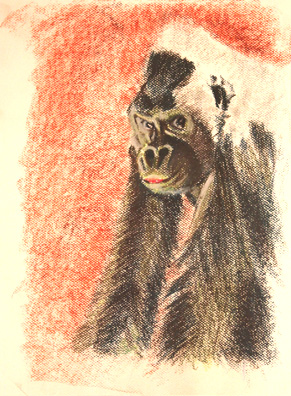Pastel Gorilla in the Style of ?????

As all true students of art know, artists often do many preliminary studies 'ere the final work is done. And this too is (probably) an "in progress" work.
Although not evident unless you see the original, this is a pretty good example of the "reduction principle" so well known in illustration. That is, if you're making an illustration for magazines, books, or newspapers (or at least when those things still existed) or for the internet (which is still around), you should work large - the original is 17" X 14" - and then reduce it photographically. It looks much better.
This pastel was rendered on a highly textured creme paper with minimal blending but with different colors overlaying the others. The lack of blending is what produces the particular sketchy quality of the drawing.
Actually this could have been the final version of the drawing - that is, if it was intended for a 1950's men's magazine. And we don't mean the men's magazines (wink, wink). No, those who remember the various "adventure" magazines - a genre of publication that evolved from magazines beginning as early as the late 19th century and continuing until the 1970's - will remember they used illustrations of a similar style to this drawing. The subject of the drawings, though, were not (always) gorillas.
The men's adventure magazines were extremely popular (at least with men) and were found gracing the racks of every supermarket in even the smallest towns and hamlets. They were a bit more respectable in terms of contemporary community standards than some of the (ahem) other men's magazines (the type that were kept behind the counter and covered up with brown wrapping paper). But there was enough titillation (no pun intended) to keep them marketable, and one way to maintain the respectability was to dress the stories (with accompanying illustrations and photographs) in the guise of nature or anthropological treatises. Despite that tack, none of these adventure magazines are still in print.
The magazines varied in quality and we have to say it in veracity. Certainly some of the "true" adventures were true enough and some magazines touted some of the best writers of the day. But in others there was the foreshadowing of what has now become commonplace - that odd blending of fact and fiction which ultimately gave us the oxymoron of the "non-fiction novel" that finally morphed into the doubly misnamed travesty, the "docudrama". Although for any individual story it's hard to know where non- and the -fiction met, the notes of one of the "adventurer journalists" have come to light. The story told of how during the author's wandering through the Asian jungles he saved his life by thrusting his arm down the throat of an attacking tiger. Stirring stuff, indeed. But the notes - which weren't part of the published story - mention 1) he had heard the story from a third party, 2) the editor found the conclusion "implausible", and so 3) the author obligingly rewrote the ending.
But as an Italian politician once asked,"What is truth?"